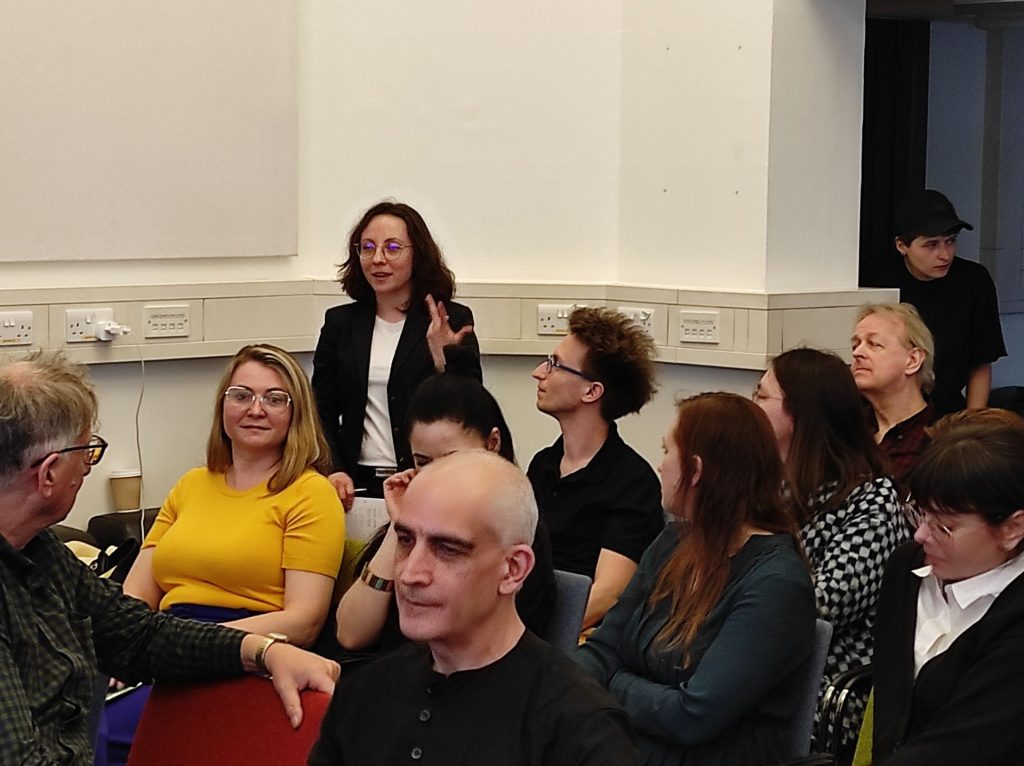The Logic of Collecting
By confrontations, on 28 August 2022
By Pavlína Morganová
![]()
 Christine Macel’s presentation was one of the public events of Confrontations sessions in London. This well attended guest lecture at UCL’s Institute of Advanced Studies was a great opportunity to meet the chief curator of the Centre George Pompidou and director of 2017 Venice Biennale. Macel talked openly about the museum’s collections and the works which represent art from Eastern and Central Europe. She revealed some of the strategies, but also frustrations, connected to the acquisitions process. She even showed a list of artists, which the museum is targeting. One could read names, such as Milan Grygar, Karel Malich, Václav Boštík, Vjencislav Richter, Goran Trbuljak, Stano Filko, Milan Knížák, Katalin Ladik, Anna Kutera, Ewa Partum, Jarosław Kozłowski, Endre Tót, Tamás Szentjoby, Maria Pinińska-Bereś, Mirosław Bałka, Katarzyna Kozyra, Milica Tomić or IRWIN. (Pavlína Morganová)
Christine Macel’s presentation was one of the public events of Confrontations sessions in London. This well attended guest lecture at UCL’s Institute of Advanced Studies was a great opportunity to meet the chief curator of the Centre George Pompidou and director of 2017 Venice Biennale. Macel talked openly about the museum’s collections and the works which represent art from Eastern and Central Europe. She revealed some of the strategies, but also frustrations, connected to the acquisitions process. She even showed a list of artists, which the museum is targeting. One could read names, such as Milan Grygar, Karel Malich, Václav Boštík, Vjencislav Richter, Goran Trbuljak, Stano Filko, Milan Knížák, Katalin Ladik, Anna Kutera, Ewa Partum, Jarosław Kozłowski, Endre Tót, Tamás Szentjoby, Maria Pinińska-Bereś, Mirosław Bałka, Katarzyna Kozyra, Milica Tomić or IRWIN. (Pavlína Morganová)
 Responding to Macel, Professor Briony Fer from UCL questioned the role and agency of art museums in a cultural sphere that is ultimately shaped by geopolitics and market forces. Although the collecting strategies towards Eastern Europe of the two institutions were not directly confronted during the presentations, there was a sense that Tate Modern pursues a more systematic and rigorous approach, relying on an infrastructure of advisory committees, while the Pompidou is more ad hoc but potentially faster moving in responding to the changing art historical landscape of the region.
Responding to Macel, Professor Briony Fer from UCL questioned the role and agency of art museums in a cultural sphere that is ultimately shaped by geopolitics and market forces. Although the collecting strategies towards Eastern Europe of the two institutions were not directly confronted during the presentations, there was a sense that Tate Modern pursues a more systematic and rigorous approach, relying on an infrastructure of advisory committees, while the Pompidou is more ad hoc but potentially faster moving in responding to the changing art historical landscape of the region.
 Contributions from the floor also raised issues around the implications of the war in Ukraine for curatorial and collecting policies towards a region that is undergoing geopolitical redefinition. Members of the Confrontations group tested the boundaries of the expansion of institutional collecting by asking whether there is or would ever be room for works of socialist realism in the collection displays of the history of modern art. The discussion broached further questions around the comparison of the general state of research into East European art in the United Kingdom and France, and the extent to which academic and museological structures are conducive to research into the art of the region. (Maja & Reuben Fowkes)
Contributions from the floor also raised issues around the implications of the war in Ukraine for curatorial and collecting policies towards a region that is undergoing geopolitical redefinition. Members of the Confrontations group tested the boundaries of the expansion of institutional collecting by asking whether there is or would ever be room for works of socialist realism in the collection displays of the history of modern art. The discussion broached further questions around the comparison of the general state of research into East European art in the United Kingdom and France, and the extent to which academic and museological structures are conducive to research into the art of the region. (Maja & Reuben Fowkes)

 Close
Close

